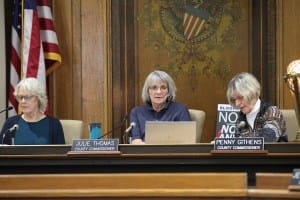Vote on governing entity for convention center expansion project put off until Jan. 8 as more time needed to dot i’s in CIB ordinance

Two years and five days ago, Monroe County commissioners councilors voted 4–3 to enact a 1-percent food and beverage tax.

The convention center expansion, which the tax is supposed pay for, will need to wait a few more weeks to get a governance structure.
Monroe County commissioners voted Wednesday morning to put off until Jan. 8, 2020, a draft ordinance that would have exercised their power under a state statue to adopt an ordinance establishing a capital improvement board (CIB).
Chair of the board of commissioners, Julie Thomas, said the ordinance was “not quite ready for prime time.”
But it appears that the city of Bloomington and Monroe County have put the major differences behind them that have stalled the project since late May.
Formation of a CIB, which is now expected early next year, will answer the question of governance for the long-planned convention center expansion project.
The timing of holidays this year means that no meetings of the commissioners will take place over the next two weeks. That makes Jan. 8 the next possible regular meeting for the CIB ordinance enactment.
The seven-member CIB will oversee the design, financing, construction, operations and maintenance of the improvements that will be a part of the $59-million convention center expansion project. The roughly $44 million required for the exhibit hall and other elements besides the parking garage will be paid for from the city’s share of the food and beverage tax. The city of Bloomington is planning to pay for the 550-space parking garage from tax increment finance (TIF) revenue.
After getting the preliminary site plan recommendation in late May, Bloomington and Monroe County officials have disagreed about the final choice of site plan. They’ve also disagreed over what entity will lead the $59-million project through final design, construction, ownership, and operation of the bigger facility.
The detritus from that disagreement over governance is evident in some of the introductory material in the draft CIB ordinance. The city of Bloomington had favored the formation of a 501(c)(3) as the governing entity. The non-profit option is described in a “whereas” clause, that says commissioners don’t support formation of a non-profit, “due to the lack of legally-required transparency, the lack of Tort Claim liability protection, and the inherent risks that are associated with the ‘flexibility’ provided to a 501(c)(3); ”
The mention of the non-profit option is one of the points in the draft CIB ordinance about which the city of Bloomington has given some feedback, county attorney Jeff Cockerill told commissioners Wednesday morning. Given that the option that’s been agreed to is a CIB, Bloomington officials don’t think the topic of a 501(c)(3) needs to be mentioned in the CIB ordinance, Cockerill said.
Cockerill also said the city wants to make sure that references to the convention center make clear that the expansion project is included.
Members of the seven-member board are limited by the CIB enabling statute to a total of four who are affiliated with the same political party. The draft local ordinance assigns three appointments each to the city and the county, with the seventh nominated by those six.
Cockerill told The Beacon after Wednesday’s meeting that the reference in the draft ordinance to the “city council” in section on appointments was meant to read simply “city.” The city and the county are meant to sort out internally how those appointments are made.
How the seventh appointment is made—by nomination followed by confirmation or instead by direct appointment of the first six appointments—is also still a topic of discussion between the city and the county.
One of the first decisions the new board will make is to choose between the northward and the eastward expansion options. The city favors the northward expansion, the county eastward. A nine-member steering committee recommended the northward expansion in late May, after shepherding preliminary site plans through a public engagement process.
Once the direction of the expansion is settled, work on the final design can start. The project’s architect is Convergence Design. The project’s late-year momentum includes the approval on Dec. 11, by Bloomington’s city council of a roughly $6 million appropriation ordinance to pay for the project’s architect fees.
The key to the CIB’s ability to serve its function of reflecting the city and county’s joint effort on the project will be an interlocal agreement. The agreement will supplement the CIB ordinance, spelling out some ways that the city of Bloomington will exercise some control, while still following the letter of the CIB statute.
A bulleted list of elements related to a CIB, which Bloomington officials would like to see put into an interlocal agreement, was first released last Wednesday (Dec. 11) at meeting between city and county officials. The following day, numbers had been added to the list to allow for easier discussion.
A discussion on Dec. 12 between county and city officials about the numbered list didn’t identify any deal-breaking points.
One of the basic principles that’s baked into the draft ordinance is the idea that no elected officials or employees for either the county or the city will be members staff of the CIB.
The commissioners have a meeting scheduled at 4 p.m. Thursday (Dec. 19) to continue work on the interlocal agreement that will accompany the CIB.




Comments ()